MV Lab Integration with CPV Lab / CPV One
This guide explains how MV Lab works together with CPV Lab (and CPV One) so you can track which landing page variation performs best ( How to Track & Measure Page Variations) We show the exact steps to set up tracking, how to view variation data in Stats, and how to use macros (wildcards) to insert dynamic text into variations.
Quick summary — what you will learn
- Enable multivariate tokens so CPV Lab captures which variation visitors saw
- Assign MV Lab page variations to a campaign and domain
- View the variation index or the full variation text inside CPV Lab Stats
- Use wildcards (macros) (
{!parameter!}) inside variation text to show dynamic values from the page URL - How to test and verify everything is working
How MV Lab + CPV Lab work together (short)
- MV Lab shows different variations of a page element (headline, image, CTA) on each page load.
- CPV Lab records clicks and includes tokens that track which variation was shown (for each snippet).
- With these tokens CPV Lab can show which combination of variations gives the best CTR, CVR, engagement, and other metrics.
Step-by-step setup (what you must do)
For CPV Lab or CPV One to track the combination of variations from the landing page, there are a few steps to follow:
1) Enable Extra (Multivariate) tokens in your campaign
To track which MV Lab variation a visitor saw, your CPV Lab campaign must include Multivariate Tokens.
- Open the campaign in CPV Lab / CPV One.
- Find the Macros & Tokens section and check the "Tokens" dropdown control.
- Select a multivariate token number (for example
Multivariate 1,Multivariate 2, ...).- When you select
Multivariate X, the parameter that will be added to the campaign URL becomes:{multivariateX} - On the landing page this will appear as a URL parameter like:where
?multivariate1=var2var2means "variation index 2" for that snippet.
- When you select
Tip: pick different Multivariate token numbers for different snippets (headline, CTA, etc.) so CPV Lab captures each snippet separately.
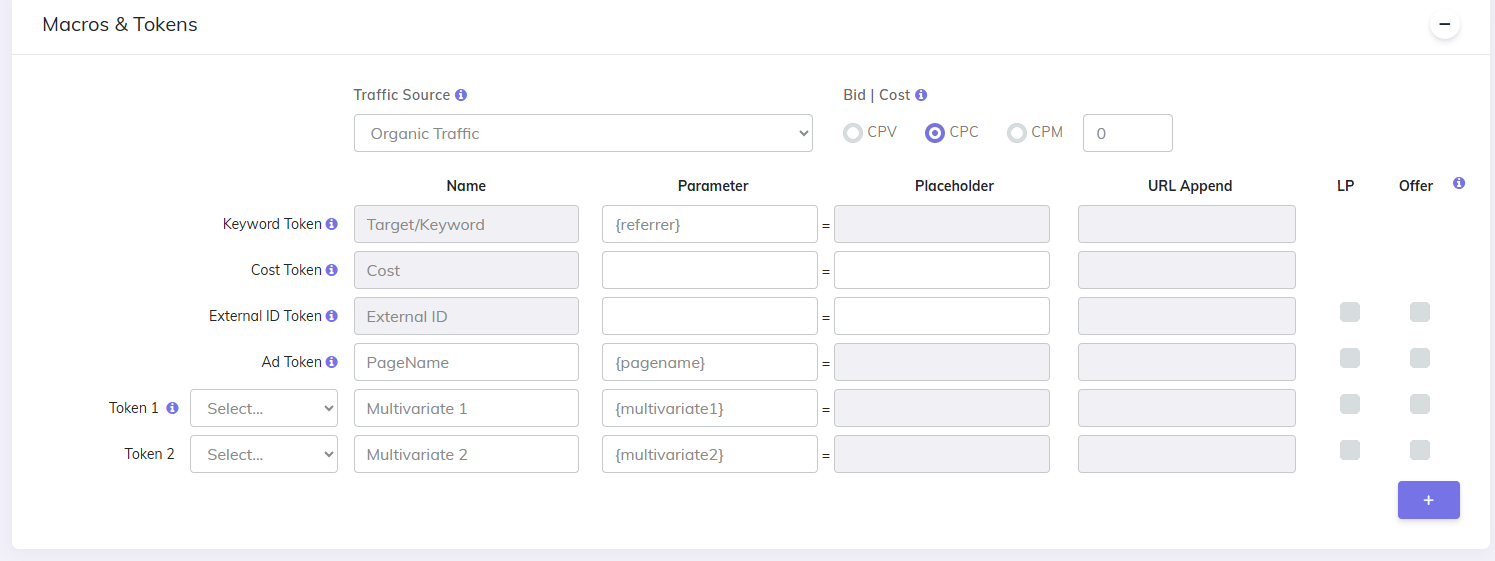
2) Assign the right campaign to the MV Lab page variation
When you generate code in MV Lab you must choose the CPV Lab / CPV One campaign that will track the page.
- In MV Lab, when creating the page variation, select the Campaign field and pick the campaign you want to use.
- Each snippet will have an Extra Token assigned if the campaign was setup correctly.
- This links the generated page code with your CPV Lab campaign tracking.
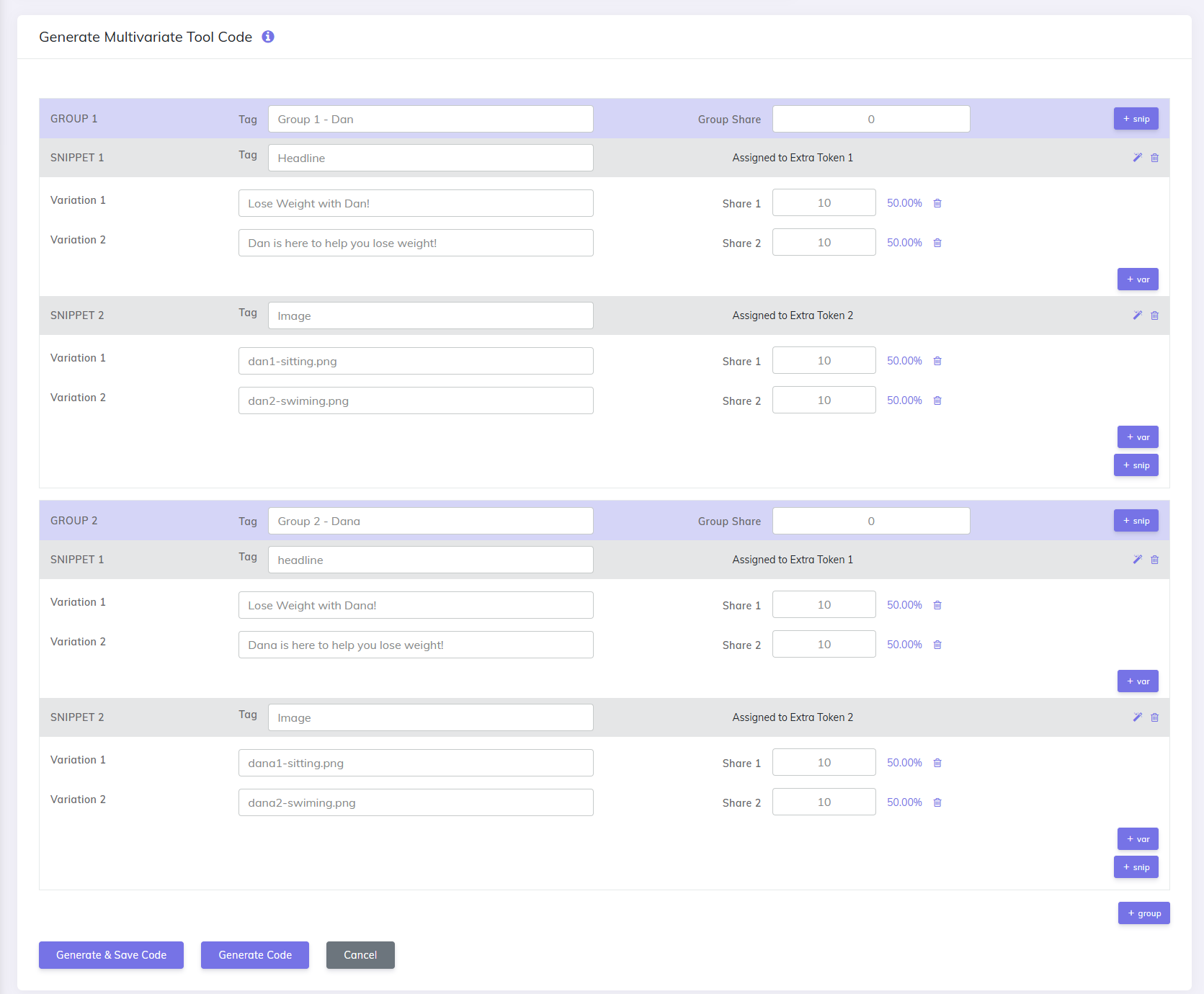
3) Set the correct domain
Make sure the domain selected in MV Lab is the domain where you will upload the HTML.
- In MV Lab: select the Domain (where the page will live).
- In CPV Lab: the campaign must accept traffic for that same domain (no cross-domain mismatch).
4) Test the campaign and page
After you create the MV Lab landing page and assign it to a campaign:
- Load the Campaign URL for your tracking campaign in the browser
- The CPV Lab campaign landing page URL should be the landing page with the multivariate code inside the page CTA).
- Visit the landing page several times (refresh the page). Each refresh can show a different variation.
- In CPV Lab, open the Campaign Stats and check the multivariate tokens to see which variations were recorded.
- See: Campaign Stats
Show variation text in CPV Lab Stats
By default CPV Lab shows variation index as var X (for example var 1, var 2) in camppaign stats.
You can instead show the actual variation text (the real headline or CTA text) in the Stats table.
How to enable real variation text:
- In MV Lab settings look for Show Variation Text instead of Index in Stats (on the right side of the screen)
- Check (enable) Show Variation Text instead of Index in Stats.

Notes:
- MV Lab will display up to a default number of characters (usually 50) for each variation text to keep the Stats table tidy.
- If you need more characters, change the Limit Variation Texts option (increase the limit) for that Page Code Variation.
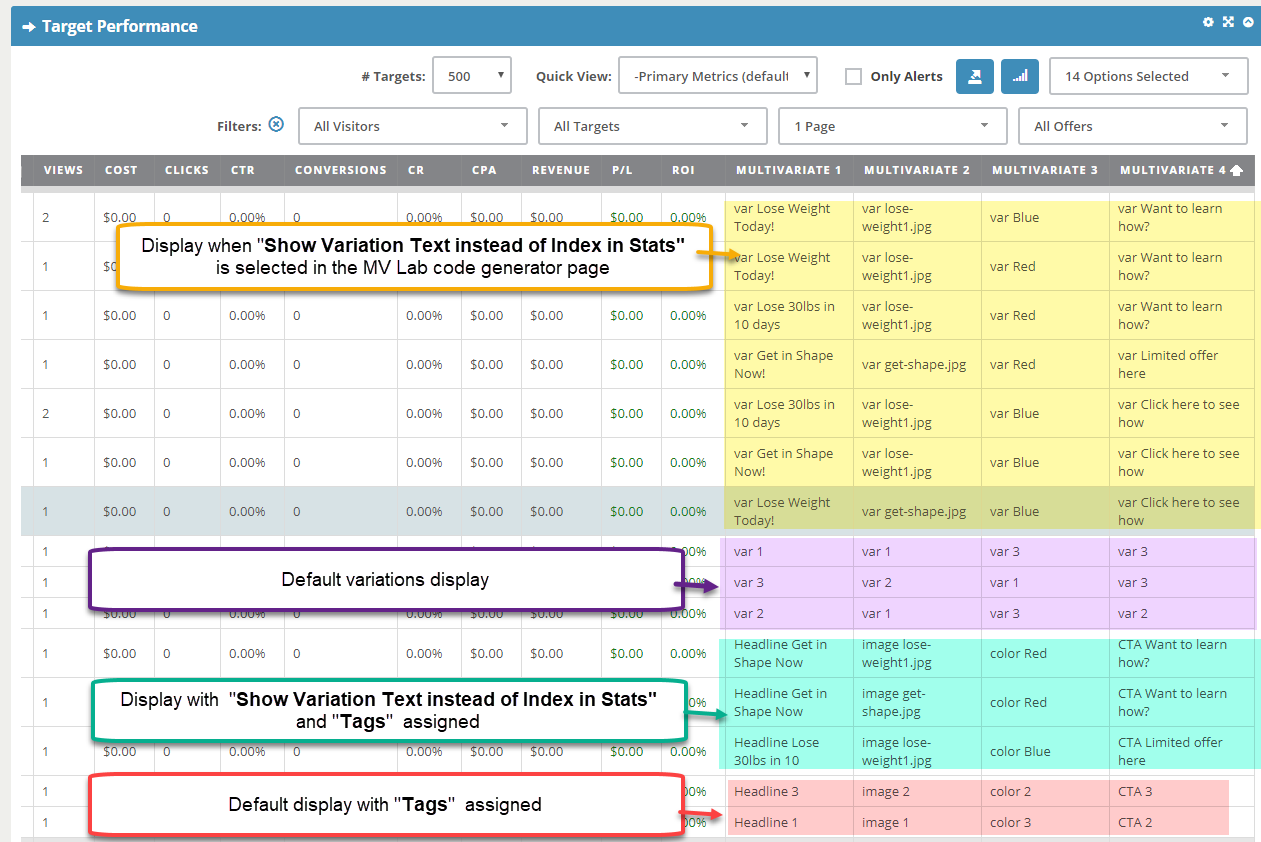
Example: how variations appear in Stats
- Default:
var 1,var 2, etc. - With Show Variation Text enabled: you will see a short excerpt of the real variation text (e.g.,
Save 30% on Shoes).
This lets you read and understand which exact copy version produced the best result.
Dynamic Content (wildcards) in variations
MV Lab allows to add macros (placeholders or wildcards) in your variation texts and these will get replaced with the corresponding value passed in the parameter from Landing Page URL.
This means that you can have dynamic content in your variations. When the page runs, those macros are replaced with values from the landing page URL.
The formats of the macro (wildcard) that can be included in the variation text are:
- simple format:
{!parameter!} - advanced format with default value:
{!parameter::default-value!}where:- parameter - is the name of the parameter that will be read from the landing page URL
- default-value - is the value that will be displayed if the parameter doesn’t exist in the landing page URL
- simple format:
Here is a list with the macros you can use for your landing page in CPV Lab | CPV One.
To make it easier to include these parameters in MV Lab variations, they can be selected from the overlay window that appears below the variation textboxes:

Example: show visitor city in headline:
- Your campaign sends the visitor city in the city parameter.
Example landing page URL:
https://yourdomain.com/page.html?city=London
or if CPV Lab sends it:
https://yourdomain.com/page.html?city={!mm_city!}
TIP
Here is an example page to see it in action: https://cpv.testinglab.pro/tests/mvlab-parameters-sample.php?city={!mm_city!} (opens new window)
- In MV Lab, use a variation text like:
Great deals in {!city!}
When a visitor from London opens the page, the heading becomes:
Great deals in London
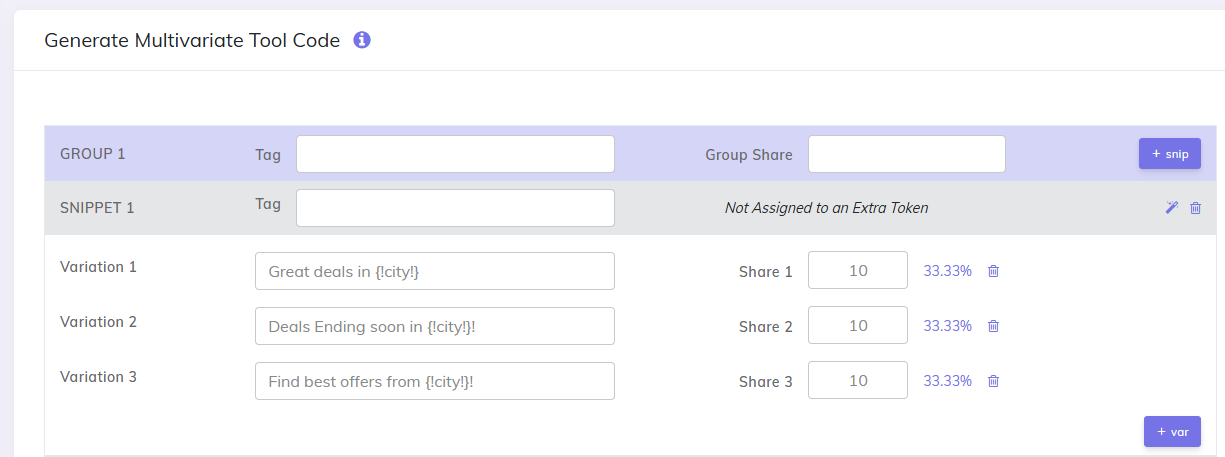
- If the city parameter is missing, use a default:
Great deals in {!city::You City!}
If no city is present, the text shows:
Great deals in Your City
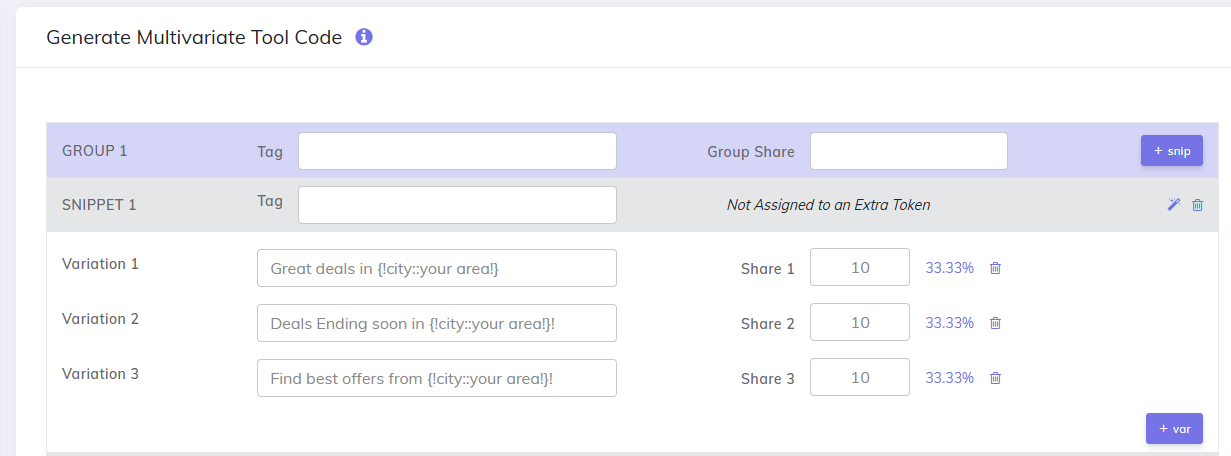
Test example — try the campaign URL
You can test a sample campaign by loading the CPV Lab campaign URL below multiple times. Each load will show a different variation and CPV Lab will record the multivariate tokens.
Example test URL (sample):
https://cpv.testinglab.pro/base.php?c=47&key=8dd87043453cbec842d104764c23ef28
- Refresh the URL several times.
- Check the Campaign Stats for values in the multivariate token columns (or variation text if you enabled it).
Quick reference: token names & examples
| What you enable | How it appears in URL | What it means |
|---|---|---|
| Multivariate token selection | multivariate1 = snippet #1; | |
| Macro simple | {!city!} | Replaced with city URL parameter value |
| Macro with default | {!city::Your City!} | Uses Your City or any default text if city not present |
Troubleshooting & tips
I see var 1 instead of the real text
- Enable Show Variation Text instead of Index in Stats in MV Lab settings.
- Increase Limit Variation Texts if the text is truncated.
Variation tokens are not in CPV Lab clicks
- Make sure the campaign has Multivariate Tokens enabled.
- Confirm MV Lab generated page has the campaign and domain set correctly.
- Check the landing page URL includes the multivariate parameters (open the page and look at the code).
Dynamic Macros are not replaced on the page
- Confirm the parameter is present in the page URL (e.g., ?city=Paris).
- Make sure the macro name matches the URL parameter name exactly.
- Use the advanced default macro
{!parameter::default-value!}to avoid empty text.
I changed a variation but stats are not updated
- Regenerate and re-upload the MV Lab code to the landing page.
- Verify the variations are replaced with "Snippets" in the landing page
- Refresh the Stats page and check for new clicks after visitors load the updated page.
You may also find useful:
